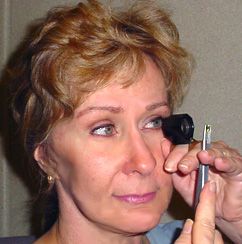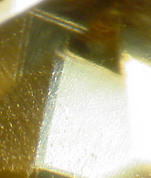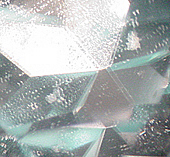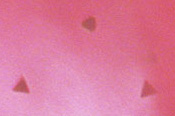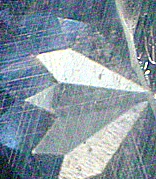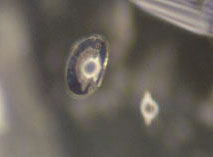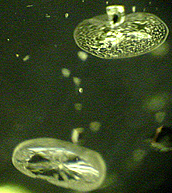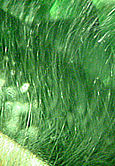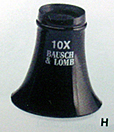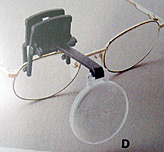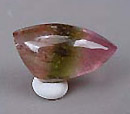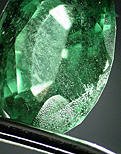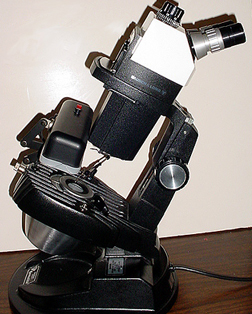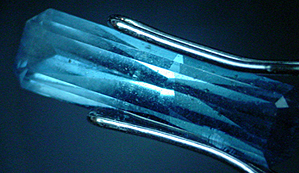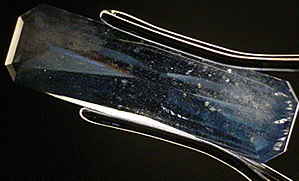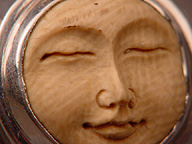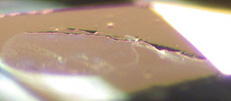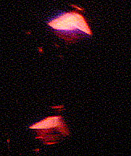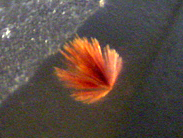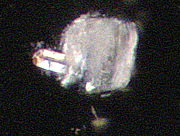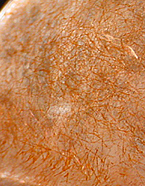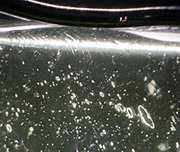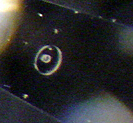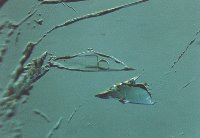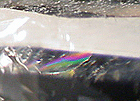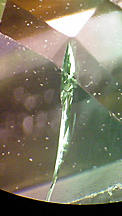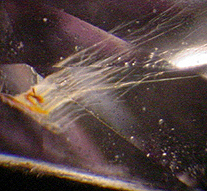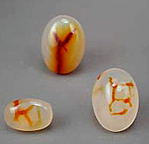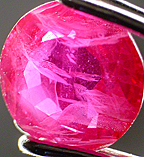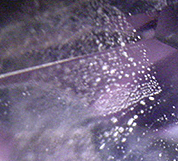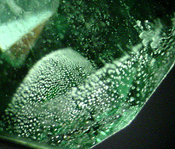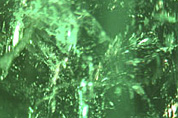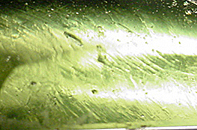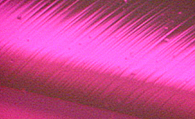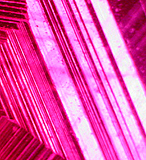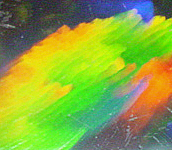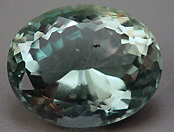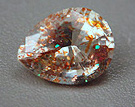1) Appraisal/insurance/repair: When you take gems or jewelry items to get them officially evaluated, perhaps due to an inheritance or insurance issue, or for investment reasons, there must be a way for the appraiser to both justify their analysis of the gem, and to document that particular stone, so that its identity can be verified in the future.
In order to assign a value to any gem, it must be graded, that is, a determination must be made as to how fine, and how rare it is, and what its "market" or "replacement" value would be. Part of the grading process which determines these values, especially in diamonds, is done under magnification.
The magnified view of any gem, plotted onto a diagram, can then serve as its "fingerprint". It is about as unlikely that two gems will have the same number, location, and type of inclusions and internal growth features, as it is that two people will have the same fingerprints, or the same DNA.
Such a drawing will also give the jeweler who is receiving a valuable jewelry item for cleaning or repair, and the customer, a way to verify that the gem taken in is, in fact, the same one which is returned.
2) Gem Identification/Gem History: In general, the three questions a gemologist or appraiser (or a savvy buyer!) has to ask about an unknown gem are:
What is it? Although this question can usually be answered by tests of those physical and optical properties discussed in Lessons 3 and 4, finding certain inclusions can make the job easier, and in some cases eliminate the need for further tests. In addition, some optical and physical properties are best revealed under magnification.
[The characteristic growth tubes inside this gem narrow the most likely identification possibilites to beryl and tourmaline (it's a tourmaline)] [The doubled facet reflections seen under magnification in this sphene and zircon, serve as clues to gem identity: few species have birefringence this high] Is it natural or synthetic? Once the question of the species or variety has been answered, then it is necessary to know whether the gem is natural or synthetic. (Remember, synthetics are the gem, and, therefore, have all the chemical, physical and optical properties of the natural version). One of the best tools at a gemologist's disposal, in trying to make this call, is magnification.
There are certain inclusions found only in natural stones, and others found only in synthetics. In many cases, then, seeing a certain inclusion is definitive. Unfortunately, there are also inclusions which can be found in either type, and some gems that are so totally clean, there are no inclusions to use.
[The triangular platinum crystals which were eroded from the crucible in which this synthetic Alexandrite was formed, give proof of its man-made origin] Has it been enhanced, and if so, how? Certain enhancements (and imitations) can be most easily detected by a magnified view of the surface, or the interior, of a gem.
[The intact "silk" (rutile needles) in this sapphire proves that it has not been subjected to high heat, and is of natural color, whereas the stress fractures in this heated sapphire give evidence of its treated state: Image courtesy of Martin Fuller] Where, specifically, did it come from? Though not a factor in most cases, there are a few important instances where the geographic location of a gem's origin is crucial in setting its value. In those situations, it is often possible by seeing diagnostic inclusions or growth features to specify the location. Only peridot from Arizona shows a characteristic stress fracture/included crystal combination known as a "lily pad", and only demantoid garnet from Russia, shows microscopic curving fibers of bryssolite asbestos known as a "horsetail".
[Lily pads in Arizona peridot, a horsetail inclusion in Russian demantoid garnet]
3) You can see very cool things! Looking into a gem can reveal a world of beauty and complexity that just isn't apparent from a surface view.
The two tools most often employed in gemstone magnification are the loupe and the gem microscope.
The loupe: A loupe is a small magnifying device, which, most commonly, magnifies the object to be viewed to ten times its size (10x). There are five major types used by those observing gems: handheld, eye socket, headpiece, eyeglass, and darkfield. Each has its advantages and particular best use. The handheld version is the most versatile, and the darkfield type supplies a source of specialized lighting important in some aspects of gem identification and/or grading. The eyesocket, headpiece and eyeglass types have the advantage in situations where leaving the hands free is important.
[Loupes: handheld, eye socket, headpiece, eyeglass (images courtesy of www.riogrande.com), darkfield]
In general, the advantage of a loupe over a microscope is its portability and low cost. On the other hand, the loupe's capabilities of magnification and lighting are limited compared to most microscopes.
Some of you probably already own a loupe or have taken the advice from the course syllabus and recently acquired one. So, before we get any further into the technical aspects of magnifying tools and techniques, let me give a warning: Use this tool with caution--> the view can be scary sometimes! The first time a new loupe-user looks at their favorite piece of gemstone jewelry at 10x, they are in for for a rude awakening.
A piece of gemstone jewelry which has been worn to any extent (and which looks perfectly fine to the naked eye) shows, to the examiner with a loupe, scratches and gouges in the metal, and glaring manufacturing flaws like incomplete solder joints. Upon turning his/her attention to the gem, what meets the eye is globs of dirt and grime surrounding the gem, and in most cases startlingly visible "crud" inside the gem, and/or worrisome chips, scratches or fractures on its surface.
By way of demonstration, let's look at a couple of perfectly lovely gemstones: a (rather expensive) Tsavorite garnet, and a modestly priced bicolored tourmaline cabochon.
The Tsavorite gem has no visible problems and looks great, completely transparent and full of sparkle and color. The tourmaline, as is the case with most cabochon gems, is of lower quality than a piece that would have been faceted, and is translucent, but still very attractive.
The view using our loupe, is somewhat different:
OK, now that I've properly warned you, let's look on the bright side and view some of the "very cool" things mentioned above:
Here's a nice dendritic chalcedony which at 10x really shows the three dimensional nature of the dendrites and gives some insight into their growth pattern as well.

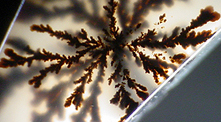
Two interesting drusy gems, but at 10x we can actually tell that their surfaces are lined with real crystals (albeit small).
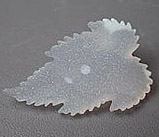

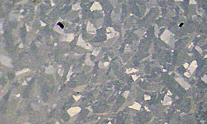
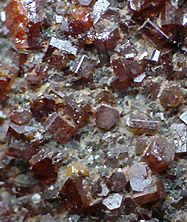

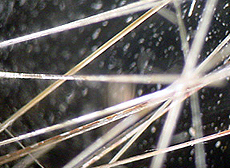
The pair of pictures below is of the same inclusion within a gem--> the gem has been tilted about 30 degrees in the second shot. What you are seeing is the movement of a gas bubble within a pool of liquid within a cavity in the gem. The first time you look inside a rock and see something moving it's quite a thrill! Such a moveable bubble is referred to as an "enhydro" and is much sought after by collectors.
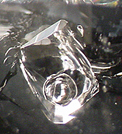
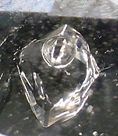
Check the web: This website gives a visual demonstration of how interesting and different ordinary things can look when they are magnified: http://www.theimage.com/closeup/
Triplet Loupes: The highest quality (and most expensive) loupes actually consist of a set of three glass lenses fitted together, and are referred to as "triplets". Together, the set of lenses corrects for the inevitable distortion introduced when a single lens is used.
This distortion is of two types: chromatic and spherical, and both types are caused by the curved shape of the lens, particularly at the edges where the curvature is the greatest. In chromatic distortion, the unequal bending of the different color wavelengths creates dispersive color fringes at the edges of view. In spherical distortion, a similar mechanism causes the image itself to curve and be out of focus in those areas.
Single lens loupes are available at very low cost, and are just fine for non-professional applications. If your loupe is not a triplet type, no need to worry--> all you need to do to compensate, is to confine your observations to the central area under view, and things will be fine.
Hand loupes can be found from 2x to 30x magnification. It might seem a good choice to purchase the one with the highest power, but typically that is not the case. There are three reasons:
1) The higher the power of magnification, the shorter the "focal length" --> the distance from the lens to the object so that it is in focus. For a 10x lens that distance is one inch, (20x = 1/2 inch, and 30x = 1/3 inch). It is difficult enough to work with a 1" clearance, let alone any of those shorter distances!
2) The shorter the focal length (higher power) the less light can enter the gem. Again, getting proper lighting at a distance of 1" can be a challenge, but it is very much more difficult at the shorter distances available at higher magnifications.
3) The higher the power of magnification, the smaller the "focal area" --> the size of the patch that you are magnifying. It can take quite a while to throughly examine all areas of a gem while using 10x, the job becomes harder, the smaller the "patches" you are looking at.
It should not be surprising then, that the vast majority of loupes in use are 10x.
Most loupes come with a metal cover that doubles as a "finger hold" or handle. The correct technique for using a loupe is pictured and described below:
